Jazz is a music genre that originated in the African-American communities of New Orleans, Louisiana, in the late 19th and early 20th centuries, with its roots in blues and ragtime. Since the 1920s Jazz Age, it has been recognized as a major form of musical expression in traditional and popular music. Jazz is characterized by swing and blue notes, complex chords, call and response vocals, polyrhythms and improvisation. Jazz has roots in European harmony and African rhythmic rituals.
Ragtime, also spelled rag-time or rag time, is a musical style that had its peak from the 1890s to 1910s. Its cardinal trait is its syncopated or "ragged" rhythm. Ragtime was popularized during the early 20th century by composers such as Scott Joplin, James Scott and Joseph Lamb. Ragtime pieces are typically composed for and performed on piano, though the genre has been adapted for a variety of instruments and styles.

Scott Joplin was an American composer and pianist. Dubbed the "King of Ragtime", he composed more than 40 ragtime pieces, one ragtime ballet, and two operas. One of his first and most popular pieces, the "Maple Leaf Rag", became the genre's first and most influential hit, later being recognized as the quintessential rag. Joplin considered ragtime to be a form of classical music meant to be played in concert halls and largely disdained the performance of ragtime as honky tonk music most common in saloons.
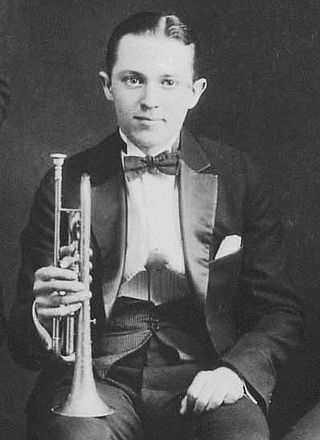
Leon Bismark "Bix" Beiderbecke was an American jazz cornetist, pianist and composer.
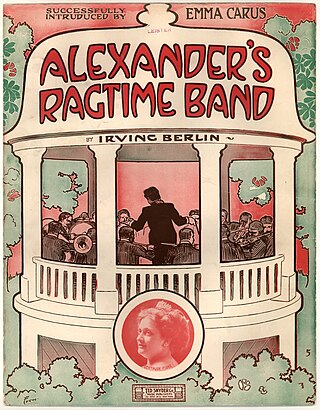
"Alexander's Ragtime Band" is a Tin Pan Alley song by American composer Irving Berlin released in 1911; it is often inaccurately cited as his first global hit. Despite its title, the song is a march as opposed to a rag and contains little syncopation. The song is a narrative sequel to Berlin's earlier 1910 composition "Alexander and His Clarinet". This earlier composition recounts the reconciliation between an African-American musician named Alexander Adams and his flame Eliza Johnson as well as highlights Alexander's innovative musical style. Berlin's friend Jack Alexander, a cornet-playing African-American bandleader, inspired the title character.

Joseph Vernon "Big Joe" Turner Jr. was an American blues shouter from Kansas City, Missouri. According to songwriter Doc Pomus, "Rock and roll would have never happened without him". Turner's greatest fame was due to his rock and roll recordings in the 1950s, particularly "Shake, Rattle and Roll", but his career as a performer endured from the 1920s into the 1980s.
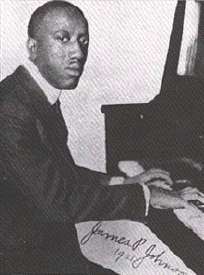
James Price Johnson was an American pianist and composer. A pioneer of stride piano, he was one of the most important pianists in the early era of recording, and like Jelly Roll Morton, one of the key figures in the evolution of ragtime into what was eventually called jazz. Johnson was a major influence on Count Basie, Duke Ellington, Art Tatum, Thelonious Monk, and Fats Waller, who was his student.
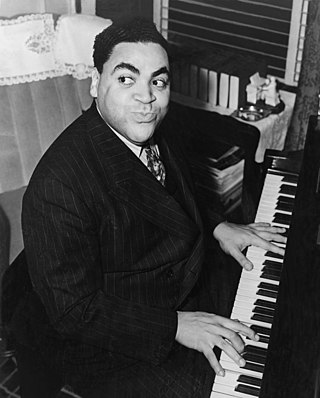
Stride jazz piano, often shortened to stride, is a jazz piano style that arose from ragtime players. Prominent stride pianists include James P. Johnson, Willie "the Lion" Smith, Fats Waller, Luckey Roberts, and Mary Lou Williams.

Music of Missouri has a storied musical history. Missouri has had major developments in several popular music genres and has been the birthplace or career origin of many musicians. St. Louis was an important venue for early blues, jazz, country, and bluegrass. Kansas City has had famous performers such as Charlie Parker, Count Basie, Lester Young, and the distinct style of Kansas City jazz. Ragtime made influence in the city of Sedalia, Missouri, due to Scott Joplin and his publisher John Stark, and through Missouri native James Scott.

Francis Joseph "Muggsy" Spanier was an American jazz cornetist based in Chicago. He was a member of the Bucktown Five, pioneers of the "Chicago style" that straddled traditional Dixieland jazz and swing.

Alexander's Ragtime Band is a 1938 American musical film released by 20th Century Fox that takes its name from the 1911 Irving Berlin song "Alexander's Ragtime Band" to tell a story of a society boy who scandalizes his family by pursuing a career in ragtime instead of "serious" music. The film generally traces the history of jazz music from the popularization of Ragtime in the early years of the 20th century to the acceptance of swing as an art form in the late 1930s using music composed by Berlin. The story spans more than two decades from the 1911 release of its name-sake song to some point in time after the 1933 release of "Heat Wave", presumably 1938.

Willie "The Tiger" Gant was an American jazz bandleader and pianist.
Knocky Parker, born John William Parker, II, was an American jazz pianist. He played primarily ragtime and Dixieland jazz.

Schuetzen Park is a privately owned 26-acre (110,000 m2) park located in the west end of Davenport, Iowa, United States. It was developed by the Davenport Schuetzengesellschaft as a location for the practice of target shooting in the traditional German style called "Schuetzen". The park is now owned and operated by the non-profit Schuetzenpark Gilde.
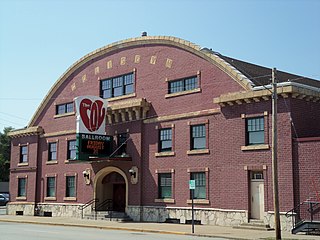
The Col Ballroom is a historic building located in the West End of Davenport, Iowa, United States. It was listed on the National Register of Historic Places and on the Davenport Register of Historic Properties as the Saengerfest Halle.

West Third Street Historic District is located on the west side of downtown Davenport, Iowa, United States. It was listed on the National Register of Historic Places in 1983. The historic district connects the central business district with the working-class neighborhoods of the West End. Its historical significance is its connection to Davenport's German-American community. Germans were the largest ethnic group to settle in Davenport.

Delmark Records is an American jazz and blues independent record label. It was founded in 1958 as Delmar Records and is based in Chicago, Illinois. The label originated in St. Louis, Missouri, in 1953 when then owner, and founder, Bob Koester released a recording of the Windy City Six, a traditional jazz group, under the Delmar imprint.

Jorge "Jordi" Rossy is a spanish jazz drummer, pianist and vibraphonist.
The George H. Buck Jr. Jazz Foundation was created by George Buck in the 1980s to maintain the catalog of his jazz record labels. The catalog includes dixieland jazz, swing, blues, rhythm and blues, gospel, and cabaret music.
















